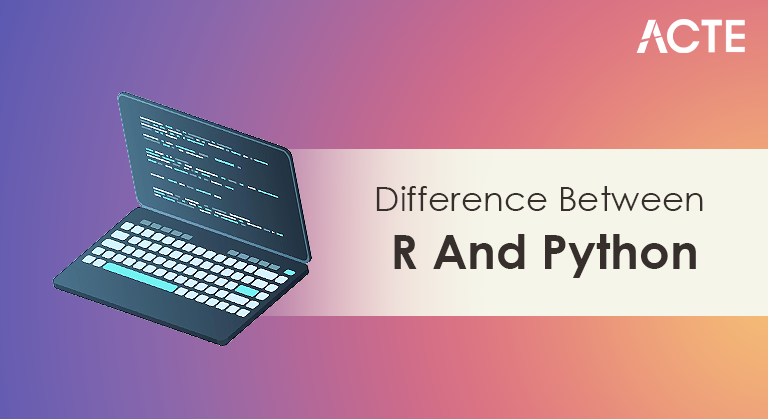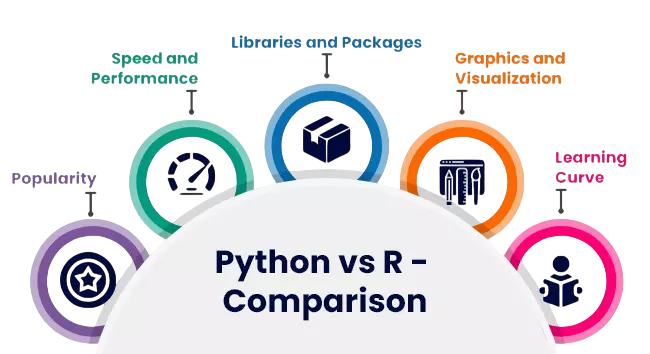
- Introduction to R and Python
- Historical Background and Development Goals
- Language Design and Syntax Comparison
- Data Analysis Capabilities
- Statistical Modeling and Simulation
- Machine Learning Support and Libraries
- Visualization Tools and Graphing Capabilities
- Conclusion
Introduction to R and Python
R and Python are two of the most popular programming languages used in data science, statistics, machine learning, and academic research. Both languages offer powerful tools and libraries that allow users to manipulate data, create visualizations, and build predictive models. However, they were developed with different goals in mind and have unique strengths depending on the use case. R was designed specifically for statistical computing and data visualization. Developed in the early 1990s by statisticians, Python Training R excels in statistical modeling, hypothesis testing, and data analysis workflows. Its extensive package ecosystem, such as ggplot2, dplyr, and caret, makes it especially popular in academic and research settings. Python, on the other hand, is a general-purpose programming language known for its simplicity, readability, and versatility. While not originally built for data science, the rise of libraries like Pandas, NumPy, scikit-learn, TensorFlow, and Matplotlib has made Python a dominant force in the field of data analysis and machine learning. Today, both R and Python are widely used across industries. Choosing between them often depends on the specific project requirements, the user’s background, and the overall ecosystem best suited to the task at hand.
Do You Want to Learn More About Python? Get Info From Our Python Online Training Today!
Historical Background and Development Goals
R was developed in the early 1990s by statisticians Ross Ihaka and Robert Gentleman with the primary goal of statistical computing and data visualization. It was designed specifically for statisticians, making it highly suitable for statistical models and advanced analytics. Python, on the other hand, was developed by Guido van Rossum in 1991 as a general-purpose programming language. Its emphasis was on readability and simplicity. Over time, with the rise of data science, Python evolved into a powerhouse What is Python Programming for data analysis and machine learning, supported by robust libraries. R was developed in the early 1990s by statisticians Ross Ihaka and Robert Gentleman as an open-source alternative to the S programming language. Its primary goal was to provide a powerful environment for statistical computing and data visualization. Python, created by Guido van Rossum in 1991, was designed as a general-purpose language with an emphasis on readability, simplicity, and broad applicability. While not initially focused on data science, Python’s flexibility led to widespread adoption across domains, including web development, automation, and eventually data analysis through community-driven libraries and tools.
Language Design and Syntax Comparison
- R is designed for statistics; Python is a general-purpose language.
- Python has simpler, more readable syntax than R.
- Functions use function() in R and def in Python.
- R uses 1-based indexing; Python uses 0-based indexing Python Developer Skills .
- R uses vectors and data frames; Python uses lists and dictionaries.
- R manages packages via CRAN; Python uses PyPI with pip.
- R is mainly functional; Python supports multiple paradigms.
- Python has a gentler learning curve compared to R.

Data Analysis Capabilities
R was built for statistical data analysis and excels in this area. It includes a wide range of packages such as dplyr, tidyr, data.table, and readr that are specifically tailored for manipulating and summarizing datasets. R is especially popular in academia and among statisticians for this reason. Python, while initially more programming-oriented, has caught up significantly with libraries like pandas, numpy, and scipy. These libraries allow users to clean, manipulate, and analyze data effectively. Building a Career as a Python Developer is often preferred when the data analysis is part of a larger software application or data pipeline. Both R and Python offer powerful data analysis capabilities, but they excel in different areas. R was built specifically for statistical computing, making it ideal for in-depth data analysis, hypothesis testing, and exploratory data visualization. Its packages like dplyr, tidyr, and ggplot2 are widely used in academic and research settings. Python, while more general-purpose, has become equally strong in data analysis through libraries like Pandas, NumPy, and Matplotlib. Python is often preferred for data workflows that involve integration with web applications, machine learning, or automation. Ultimately, both languages provide robust tools to clean, manipulate, and analyze complex datasets efficiently.
Want to Pursue a Python Master’s Degree? Enroll For Python Master Program Training Course Today!
Statistical Modeling and Simulation
R’s core strength lies in statistical modeling. It supports a wide variety of statistical techniques, including linear and nonlinear modeling, time-series analysis, and clustering. R’s CRAN repository is rich with packages developed by the statistical community. Python offers statistical modeling through libraries like statsmodels and scikit-learn, but it generally lags behind R in terms of breadth and depth of built-in statistical techniques. For tasks heavily reliant on statistics, R is often the preferred tool. R is renowned for Python Training its extensive statistical modeling and simulation capabilities, making it a favorite among statisticians and researchers. It offers a wide range of built-in functions and packages like lme4, MASS, and survival that support complex statistical analyses, hypothesis testing, and simulations. Python, although originally not focused on statistics, has caught up with powerful libraries such as Statsmodels, SciPy, and PyMC3 that enable robust statistical modeling and probabilistic simulations. Both languages provide flexible tools for fitting models, running simulations, and interpreting results, allowing users to analyze data and make predictions with confidence.
Machine Learning Support and Libraries
- Python has extensive machine learning libraries such as scikit-learn, TensorFlow, PyTorch, and Keras
- R offers strong machine learning packages including caret, randomForest, e1071, and xgboost
- Python is preferred for deep learning and production deployment Best Python IDEs and Code Editors
- R is favored in academic research and statistical modeling for machine learning
- Python benefits from large community support and frequent updates in ML tools
- R excels at quick prototyping and exploratory machine learning analysis
- Python integrates well with big data and cloud platforms
- R provides comprehensive visualization tools for evaluating machine learning models

Visualization Tools and Graphing Capabilities
- R has powerful visualization packages like ggplot2, lattice, and plotly.
- Python offers popular libraries such as Matplotlib, Seaborn, Plotly, and Bokeh.
- R’s ggplot2 is widely praised for creating complex, layered graphics with ease.
- Python’s Matplotlib is highly customizable and serves as the foundation for many other libraries Python Serialization .
- Both languages support interactive visualizations for web applications.
- Python integrates visualization with machine learning workflows seamlessly.
- R provides extensive support for statistical graphics and exploratory data analysis.
- Python’s visualization tools are often preferred for dashboards and real-time updates.
Preparing for a Python Job? Have a Look at Our Blog on Python Interview Questions and Answers To Ace Your Interview!
Conclusion
In conclusion, both R and Python are powerful programming languages with distinct strengths that cater to different needs in data science, statistical analysis, and machine learning. R, with its rich history in statistics and specialized packages, remains the preferred choice for statisticians, researchers, and those focused on detailed data analysis and visualization. Its comprehensive statistical libraries and advanced plotting capabilities make it ideal for academic and research environments. Python, on the other hand, has grown into a versatile, general-purpose language favored for its readability, broad community support, and extensive ecosystem Python Training. Python excels in machine learning, deep learning, Visualization Tools and Graphing and integration with web and cloud applications, making it the go-to language for production environments and large-scale data projects. Choosing between R and Python ultimately depends on your project requirements, background, and long-term goals. For heavy statistical modeling and rapid prototyping in research, R is unmatched. For end-to-end data workflows, including deployment and automation, Python provides a flexible and scalable solution. Many data professionals benefit from knowing both languages, leveraging R’s statistical prowess alongside Python’s versatility. As the data science field continues to evolve, proficiency in either or both will remain highly valuable and open doors to a wide range of career opportunities.


